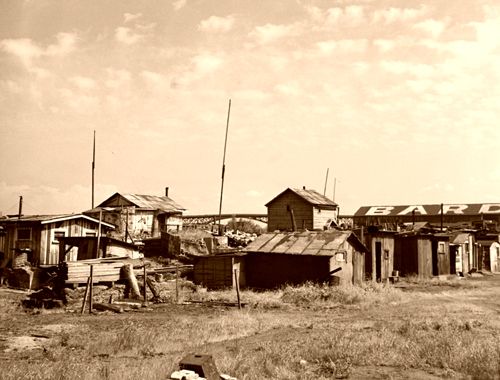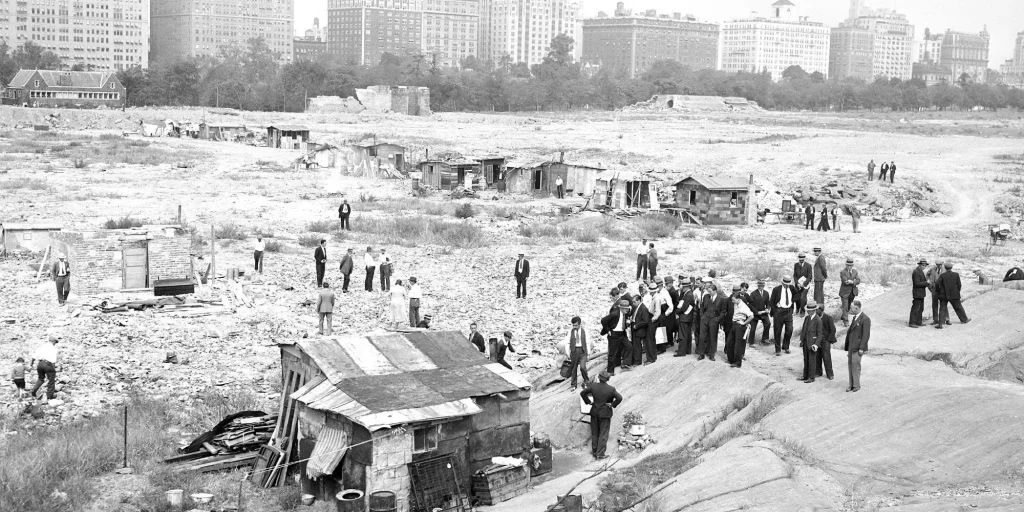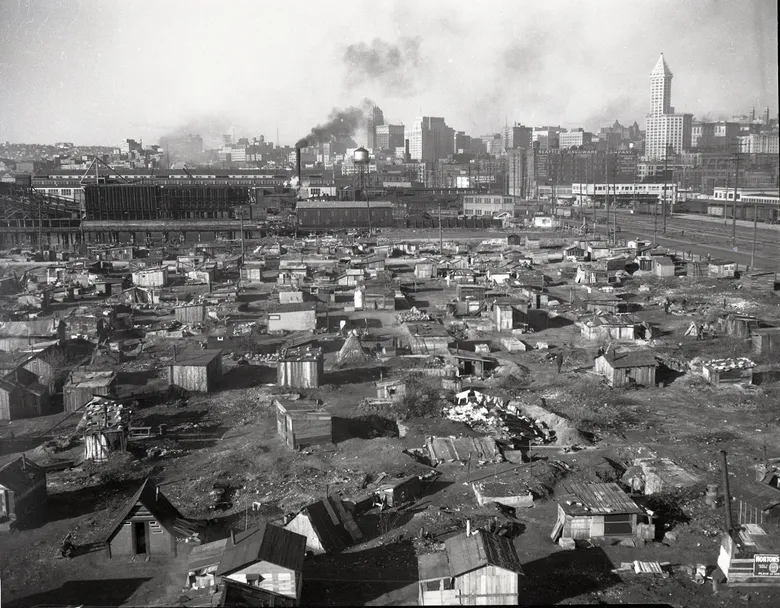In 1929, America suffered an enormous economic crisis, which remains the most severe economic meltdown in modern history. The stock market crashed, and world trade collapsed due to the Smoot-Hawley tariff.
This led to extended bank panic, as many customers withdrew their cash deposits for fear of the bank’s solvency. There was also a collapse of the money supply, which reduced lending and investments at the time.
As a result, industrial production abruptly declined, leading to price deflation and mass unemployment. More than 12 million Americans were out of work.
Many factory workers lost their jobs, and farmers lost their farms to foreclosure as crop prices dropped. Millions of Americans lost their homes as they could not pay their mortgages or taxes. Tenants were evicted by their landlords for owing rent.
Hunger, deprivation, and homelessness were the order of the day as the poverty rate increased. Many found shelter under bridges and culverts, while others squatted with relatives. All these events sparked the Great Depression of the late 1920s. Sadly, to date, there is no exact primary cause for this economic failure.

Shanty Towns in the Great Depression
As the depression worsened, many displaced Americans were desperate for shelter. As a result, the homeless built shanty Towns, also known as Hoovervilles. These camps were named after Herbert Hoover, America’s 31st President.
The Shanty Towns-Hooverilles were makeshift shacks constructed from unwanted materials such as cardboard, wood, scraps of metal, etc. These shacks were set up on unused or public lands, usually on the outskirt of the cities and towns.
Some men equipped with construction skills built their houses out of stone. The shacks sprung up near soup kitchens or places where the homeless could get free meals. Sadly, the Hoovervilles lacked amenities such as safe drinking water and sanitation.
The unemployed and destitute Americans were familiar sights in the nation between 1929-1941. The government sought to render assistance by granting reliefs, but the benefits were too limited to cater to many.

Private charities also volunteered to help but could not match the rising demands.
Despite these efforts, people remained homeless and hungry. Driven by starvation, the homeless camped in Shanty Towns-Hooverilles, depending on bread lines and street corner peddling. These settlement camps encroached on private lands.
Even when authorities raided them for trespass, the men who carried out the raid were often remorseful. So, the shanty towns were tolerated and ignored out of necessity. But, unfortunately, this was not always the case.
What Were Hoovervilles?
Again, Shanty Towns-Hoovervilles consisted of shacks and tents built by the homeless. They were primarily dominated by the most vulnerable members of society who lost their homes.
The term Hooverville was coined by Charles Michelson, the Publicity Chief of the Democratic National Committee. It was a deliberate political label highlighting that President Herbert Hoover was responsible for the penurious state of the economy. The people blamed the bad decisions and corruption of the government for the economic instability.
The name stuck once newspapers began using it to describe the Shanty Towns. In addition to this term, President Herbert Hoover’s name was used in other ways to emphasize the great depression.
For example, newspapers used to shield the needy from the cold were called “Hoover Blankets.” “Hoover Wagon” represented an automobile with horses tied to it because the owner could not afford fuel.
Also, empty pant pockets pulled inside out were called “Hoover Flags,” etc.
Hoovervilles were occupied by men, women, children, both black and white, and those of different nationalities and ethnicities.
They lived in abject poverty and had no choice but to rely on public charities or resort to begging from those who had houses. Many survived on stale bread, table scraps, or raw potato peelings.
The Population of the Shanty Towns
The Shanty Towns-Hoovervilles varied in population and size. Therefore, it may be difficult to estimate the number of people living there. In addition, most of them were unorganized, so it was challenging to identify the population within the Hoovervilles.
However, the largest Hoovervilles were in Seattle and Washington. Covering nine acres of public land, it housed about 1,200 people.

It was so organized that the people established their community government and elected an unofficial mayor, Jesse Jackson.
They enjoyed the protection of sympathetic public officials, and this Hooverville stood for ten years from 1931 to 1941. Another known shanty town across the United States is Central Park, New York City. Many homeless families camped at the Great Lawn at Central Park. However, it was removed sometime in 1933 when work began on the reservoir landfill.
Also, in 1930, St. Louis had the largest Hooverville in America, having four distinct sectors. The community depended mainly on private donations and scavenging. They also had an unofficial mayor named Gus Smith.
Life in the Shanty Town
The hardship of the great depression threw many into disarray. Life was tough, as many didn’t know where their next meal would come from. Children, women, and immigrants suffered the most. Many children dropped out of school, and their parents sent them to beg for food at restaurants.
Access to clean drinking water was limited and only made available from the ponds and rivers. People also relied on dug latrines in ditches for their sanitary needs.
Their tents were no match for the inclement weather conditions; sadly, there was no access to medical facilities. Due to the poor state of living, sickness and diseases abound, and the health agencies and local governments were too limited to help.
Eradication of the Shanty Towns
Eradicating the many Hoovervilles was quite difficult. Several attempts were made until 1941 when the Shack Elimination Program was implemented.
The Seattle Health Department established a Shack Elmation Committee, headed by the Commissioner for Health, to identify and eliminate the Shanty Towns.
The eradication program destroyed all the Shanty Towns. However, the economy was recovering, and employment had begun to rise. As a result, many people were able to gain employment and get better shelter.

